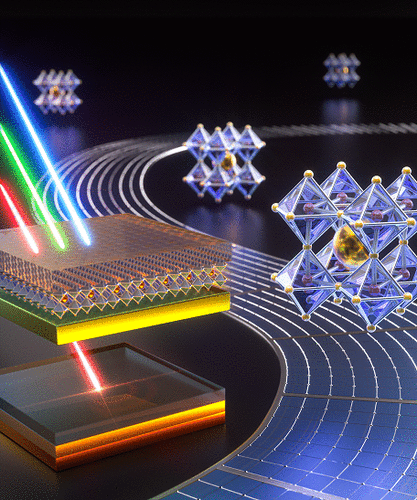当前位置:
X-MOL 学术
›
Chem. Rev.
›
论文详情
Our official English website, www.x-mol.net, welcomes your
feedback! (Note: you will need to create a separate account there.)
Perovskite Tandem Solar Cells: From Fundamentals to Commercial Deployment.
Chemical Reviews ( IF 51.4 ) Pub Date : 2020-08-07 , DOI: 10.1021/acs.chemrev.9b00780 Hui Li 1, 2 , Wei Zhang 1, 3
Chemical Reviews ( IF 51.4 ) Pub Date : 2020-08-07 , DOI: 10.1021/acs.chemrev.9b00780 Hui Li 1, 2 , Wei Zhang 1, 3
Affiliation

|
Multi-junction (tandem) solar cells (TSCs) consisting of multiple light absorbers with considerably different band gaps show great potential in breaking the Shockley–Queisser (S–Q) efficiency limit of a single junction solar cell by absorbing light in a broader range of wavelengths. Perovskite solar cells (PSCs) are ideal candidates for TSCs due to their tunable band gaps, high PCE up to 25.2%, and easy fabrication. PSCs with high PCEs are typically fabricated via a low temperature solution method, which are easy to combine with many other types of solar cells like silicon (Si), copper indium gallium selenide (CIGS), narrow band gap PSCs, dye-sensitized, organic, and quantum dot solar cells. As a matter of fact, perovskite TSCs have stimulated enormous scientific and industrial interest since their first development in 2014. Significant progress has been made on the development of perovskite TSCs both in the research laboratories and industrial companies. This review will rationalize the recent exciting advancement in perovskite TSCs. We begin with the introduction of the historical development of TSCs in a broader context, followed by the summary of the state-of-the-art development of perovskite TSCs with various types of device architectures. We then discuss the strategies for improving the PCEs of perovskite TSCs, including but not limited to the design considerations on the transparency of perovskite absorbers and metal electrodes, protective layers, and recombination layers (RLs)/tunnel junctions (TJs), with a particular focus on the band gap tuning and thickness adjustment of active layers. We subsequently introduce a range of measurement techniques for the characterization of perovskite TSCs. We also cover other core issues related to the large-scale applications and commercialization. Finally, we offer our perspectives on the future development of emerging photovoltaic technologies as the device performance enhancement and cost reduction are central to almost any type of solar cell applied in the perovskite TSCs.
中文翻译:

钙钛矿串联太阳能电池:从基础到商业应用。
由多个带隙截然不同的光吸收剂组成的多结(串联)太阳能电池(TSC)在更大范围内吸收光,具有突破单结太阳能电池的Shockley-Queisser(S-Q)效率极限的巨大潜力的波长。钙钛矿太阳能电池(PSC)具有可调节的带隙,高达25.2%的高PCE且易于制造,因此是TSC的理想选择。具有高PCE的PSC通常是通过低温溶液法制造的,易于与许多其他类型的太阳能电池结合使用,例如硅(Si),铜铟镓硒(CIGS),窄带隙PSC,染料敏化,有机和量子点太阳能电池。事实上,自2014年首次研发以来,钙钛矿TSC激发了巨大的科学和工业兴趣。在研究实验室和工业公司中,钙钛矿TSC的开发都取得了重大进展。这项审查将合理化钙钛矿TSC的近期令人兴奋的进展。我们首先在更广阔的背景下介绍TSC的历史发展,然后概述具有各种设备架构的钙钛矿TSC的最新发展。然后,我们讨论了改善钙钛矿TSC的PCE的策略,包括但不限于钙钛矿吸收体和金属电极,保护层和复合层(RL)/隧道结(TJ)的透明度的设计考虑,特别是重点关注有源层的带隙调整和厚度调整。随后,我们介绍了一系列用于表征钙钛矿TSC的测量技术。我们还将涵盖与大规模应用程序和商业化相关的其他核心问题。最后,我们提供了对新兴光伏技术未来发展的看法,因为器件性能的提高和成本的降低对于钙钛矿TSC中所应用的几乎所有类型的太阳能电池都是至关重要的。
更新日期:2020-09-23
中文翻译:

钙钛矿串联太阳能电池:从基础到商业应用。
由多个带隙截然不同的光吸收剂组成的多结(串联)太阳能电池(TSC)在更大范围内吸收光,具有突破单结太阳能电池的Shockley-Queisser(S-Q)效率极限的巨大潜力的波长。钙钛矿太阳能电池(PSC)具有可调节的带隙,高达25.2%的高PCE且易于制造,因此是TSC的理想选择。具有高PCE的PSC通常是通过低温溶液法制造的,易于与许多其他类型的太阳能电池结合使用,例如硅(Si),铜铟镓硒(CIGS),窄带隙PSC,染料敏化,有机和量子点太阳能电池。事实上,自2014年首次研发以来,钙钛矿TSC激发了巨大的科学和工业兴趣。在研究实验室和工业公司中,钙钛矿TSC的开发都取得了重大进展。这项审查将合理化钙钛矿TSC的近期令人兴奋的进展。我们首先在更广阔的背景下介绍TSC的历史发展,然后概述具有各种设备架构的钙钛矿TSC的最新发展。然后,我们讨论了改善钙钛矿TSC的PCE的策略,包括但不限于钙钛矿吸收体和金属电极,保护层和复合层(RL)/隧道结(TJ)的透明度的设计考虑,特别是重点关注有源层的带隙调整和厚度调整。随后,我们介绍了一系列用于表征钙钛矿TSC的测量技术。我们还将涵盖与大规模应用程序和商业化相关的其他核心问题。最后,我们提供了对新兴光伏技术未来发展的看法,因为器件性能的提高和成本的降低对于钙钛矿TSC中所应用的几乎所有类型的太阳能电池都是至关重要的。






























 京公网安备 11010802027423号
京公网安备 11010802027423号